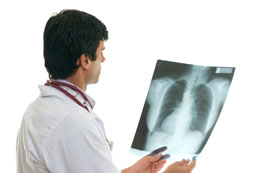A rib fracture can be quite painful and also risky if it is not treated on time. Certain rib fracture complications may also arise due to delay in treatment.

The rib cage acts as a protective shield to the vital organs (the heart and the lungs) in the thoracic cavity. This shield protects the organs from damage, which can be caused due to a heavy blow or trauma. The ribs also offer space for the expansion of the lungs during breathing. The rib cage is made up of 24 bones (or ribs), costal cartilages, sternum (or breastbone) and thoracic vertebrae, which are 12 in number. The fascia and the muscles in the thoracic wall provide anchorage to the muscles of the neck, chest, upper abdominal region and back. Though the rib cage protects the internal organs in the chest cavity, at times, it may also suffer damage and the bones may break. Broken ribs, though extremely painful in nature can also pose a risk to the internal organs. Several rib fracture complications may arise as a result of failure to recognize the severity of the damage and treat it accordingly.
How Does Rib Fracture Occur
When a strong blow affects the rib cage, it may get cracked or completely break, depending on the nature of the injury. Injuries can come in the form of automobile accidents, especially, car accidents, sports injury, impact of a fall or a trauma to the chest. Cracked and broken ribs can be quite painful to bear, but cracked ribs do not pose a threat to the organs as the jagged ribs. Most of the time, the broken ribs may heal by themselves within a couple of months, but in any case, medical intervention is a must. Broken ribs can be apparent if the individual experience sharp, stabbing pain in the chest, while taking a deep breath. A feeling of fullness in the chest and trouble bending or twisting can be observed.
Broken Rib Complications
The upper rib is protected by the clavicle or collarbone, hence, it is less susceptible to fractures, it is the lower ribs that can get affected and break, leading to fractured ribs. A lapse in treating broken ribs can lead to complications in the lower rib fracture.
- One of the risks of a rib fracture are that it can completely damage the blood vessels and injure the organs. The ruptured blood vessels can leak blood, which can accumulate in the chest region, leading to breathlessness. The blood clots may choke the wind pipe, where the person may experience shortness of breath.
- The pointed end of the broken rib can nick the carotid artery or the aorta, which is the blood vessel of the heart. This can occur when any of the first three ribs, located near the heart have broken. A rupture in the aorta can deplete the amount of blood to the heart, resulting in organ failure.
- When the middle ribs have suffered a damage, the jagged end of the broken ribs can puncture either of the lungs, depending on which side the rib has been broken. This can cause the lung to collapse and result in a condition called pneumothorax. In this condition, there is a buildup of air in the pleural cavity, due to which pressure builds in the area around the lungs, making breathing difficult. Pulmonary contusions may also occur in individuals who have broken ribs.
- Breaking of the lower ribs is quite rare, since they are more flexible when compared to the other ribs. But in case, the lower rib is broken, the sharp ends can cause lacerations in the kidneys, liver or spleen. This can damage the organs and impair their function. In the long run, they may even collapse, leading to unwanted complications.
To avoid these broken rib complications, observed when an individual suffers from an injury, which can be life-threatening in nature, rushing to the hospital immediately after an accident can be helpful in reducing the risk factors.


 The rib cage acts as a protective shield to the vital organs (the heart and the lungs) in the thoracic cavity. This shield protects the organs from damage, which can be caused due to a heavy blow or trauma. The ribs also offer space for the expansion of the lungs during breathing. The rib cage is made up of 24 bones (or ribs), costal cartilages, sternum (or breastbone) and thoracic vertebrae, which are 12 in number. The fascia and the muscles in the thoracic wall provide anchorage to the muscles of the neck, chest, upper abdominal region and back. Though the rib cage protects the internal organs in the chest cavity, at times, it may also suffer damage and the bones may break. Broken ribs, though extremely painful in nature can also pose a risk to the internal organs. Several rib fracture complications may arise as a result of failure to recognize the severity of the damage and treat it accordingly.
The rib cage acts as a protective shield to the vital organs (the heart and the lungs) in the thoracic cavity. This shield protects the organs from damage, which can be caused due to a heavy blow or trauma. The ribs also offer space for the expansion of the lungs during breathing. The rib cage is made up of 24 bones (or ribs), costal cartilages, sternum (or breastbone) and thoracic vertebrae, which are 12 in number. The fascia and the muscles in the thoracic wall provide anchorage to the muscles of the neck, chest, upper abdominal region and back. Though the rib cage protects the internal organs in the chest cavity, at times, it may also suffer damage and the bones may break. Broken ribs, though extremely painful in nature can also pose a risk to the internal organs. Several rib fracture complications may arise as a result of failure to recognize the severity of the damage and treat it accordingly.